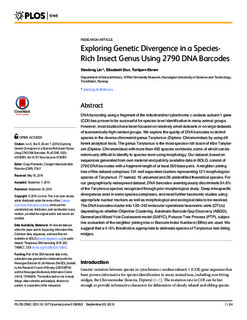| dc.contributor.author | Lin, Xiaolong | |
| dc.contributor.author | Stur, Elisabeth | |
| dc.contributor.author | Ekrem, Torbjørn | |
| dc.date.accessioned | 2015-11-03T09:57:45Z | |
| dc.date.accessioned | 2016-04-21T09:19:58Z | |
| dc.date.available | 2015-11-03T09:57:45Z | |
| dc.date.available | 2016-04-21T09:19:58Z | |
| dc.date.issued | 2015-09-25 | |
| dc.identifier.citation | PLoS ONE 2015, 10(9) | nb_NO |
| dc.identifier.issn | 1932-6203 | |
| dc.identifier.uri | http://hdl.handle.net/11250/2386690 | |
| dc.description.abstract | DNA barcoding using a fragment of the mitochondrial cytochrome c oxidase subunit 1 gene (COI) has proven to be successful for species-level identification in many animal groups. However, most studies have been focused on relatively small datasets or on large datasets of taxonomically high-ranked groups.We explore the quality of DNA barcodes to delimit species in the diverse chironomid genus Tanytarsus (Diptera: Chironomidae) by using different analytical tools. The genus Tanytarsus is the most species-rich taxon of tribe Tanytarsini (Diptera: Chironomidae) with more than 400 species worldwide, some of which can be notoriously difficult to identify to species-level using morphology. Our dataset, based on
sequences generated from own material and publicly available data in BOLD, consist of 2790 DNA barcodes with a fragment length of at least 500 base pairs. A neighbor joining tree of this dataset comprises 131 well separated clusters representing 121 morphological species of Tanytarsus: 77 named, 16 unnamed and 28 unidentified theoretical species. For our geographically widespread dataset, DNA barcodes unambiguously discriminate 94.6% of the Tanytarsus species recognized through prior morphological study. Deep intraspecific divergences exist in some species complexes, and need further taxonomic studies using appropriate nuclear markers as well as morphological and ecological data to be resolved. The DNA barcodes cluster into 120–242 molecular operational taxonomic units (OTUs) depending on whether Objective Clustering, Automatic Barcode Gap Discovery (ABGD), Generalized Mixed Yule Coalescent model (GMYC), Poisson Tree Process (PTP), subjective evaluation of the neighbor joining tree or Barcode Index Numbers (BINs) are used. We suggest that a 4–5% threshold is appropriate to delineate species of Tanytarsus non-biting midges. | nb_NO |
| dc.language.iso | eng | nb_NO |
| dc.publisher | Public Library of Science | nb_NO |
| dc.rights | Navngivelse 3.0 Norge | * |
| dc.rights.uri | http://creativecommons.org/licenses/by/3.0/no/ | * |
| dc.title | Exploring Genetic Divergence in a Species-Rich Insect Genus Using 2790 DNA Barcodes | nb_NO |
| dc.type | Journal article | nb_NO |
| dc.type | Peer reviewed | nb_NO |
| dc.date.updated | 2015-11-03T09:57:45Z | |
| dc.source.volume | 10 | nb_NO |
| dc.source.journal | PLoS ONE | nb_NO |
| dc.source.issue | 9 | nb_NO |
| dc.identifier.doi | 10.1371/journal.pone.0138993 | |
| dc.identifier.cristin | 1275774 | |
| dc.description.localcode | © 2015 Lin et al. This is an open Access article distributed under the terms of the Creative
Commons Attribution License, which permits
unrestricted use, distribution, and reproduction in any
medium, provided the original author and source are
credited. | nb_NO |

